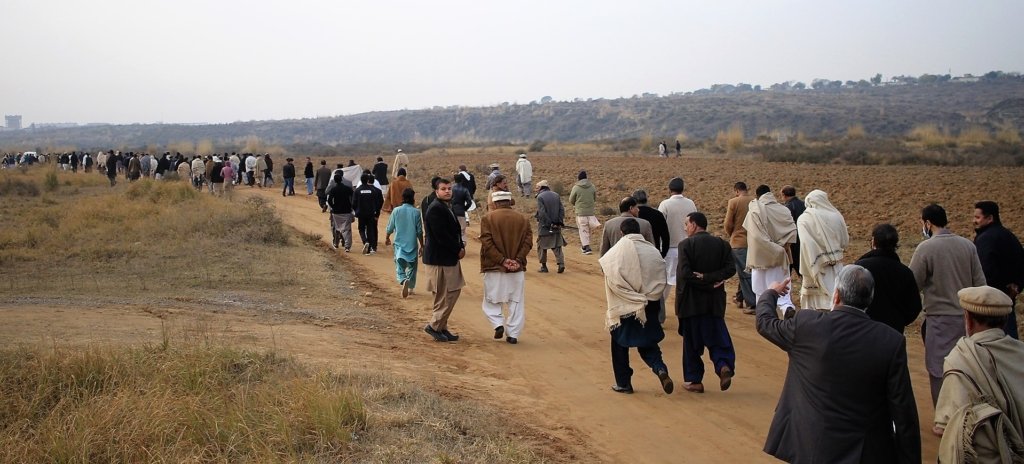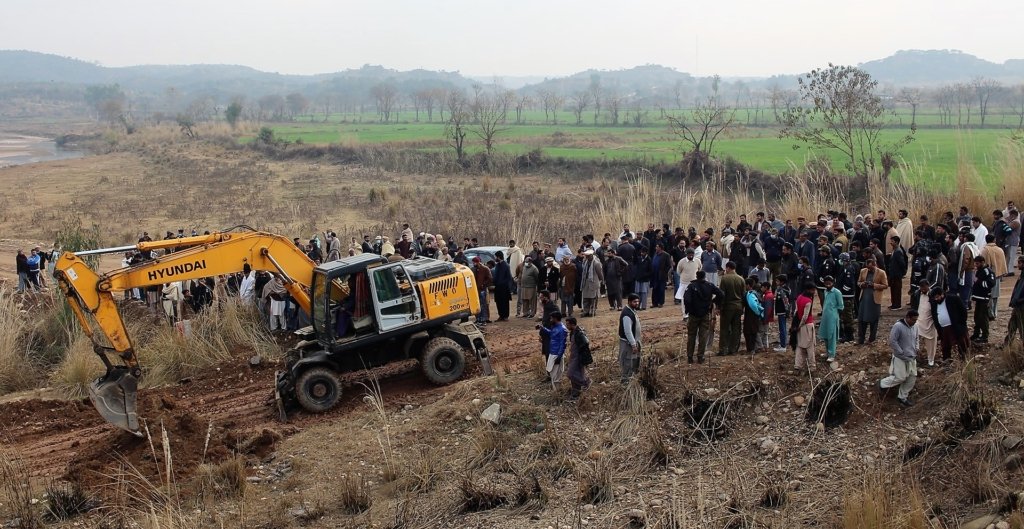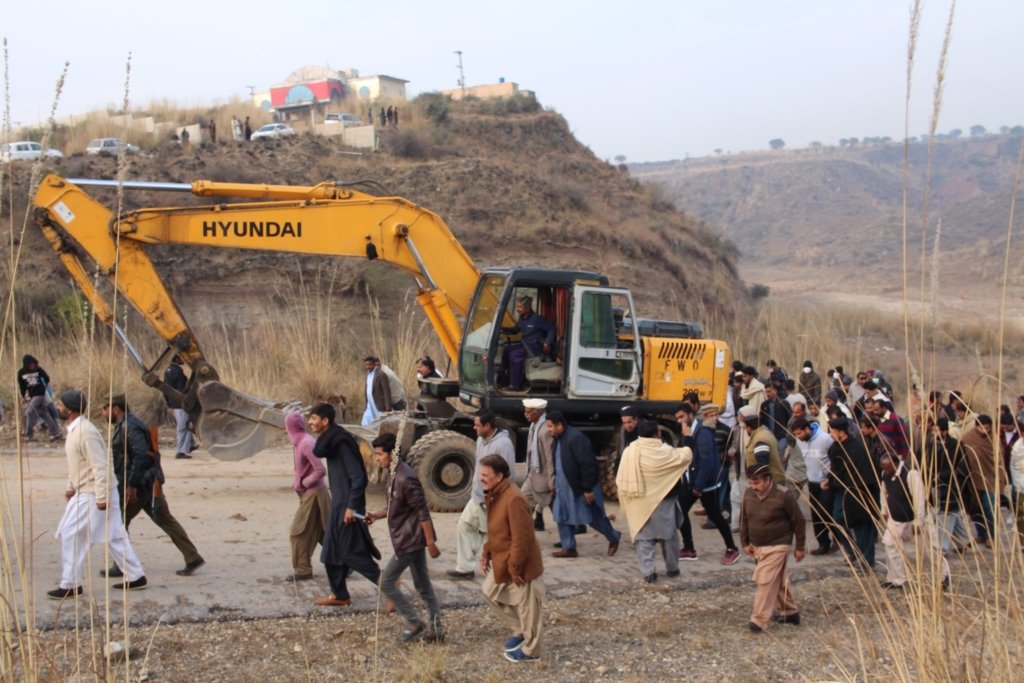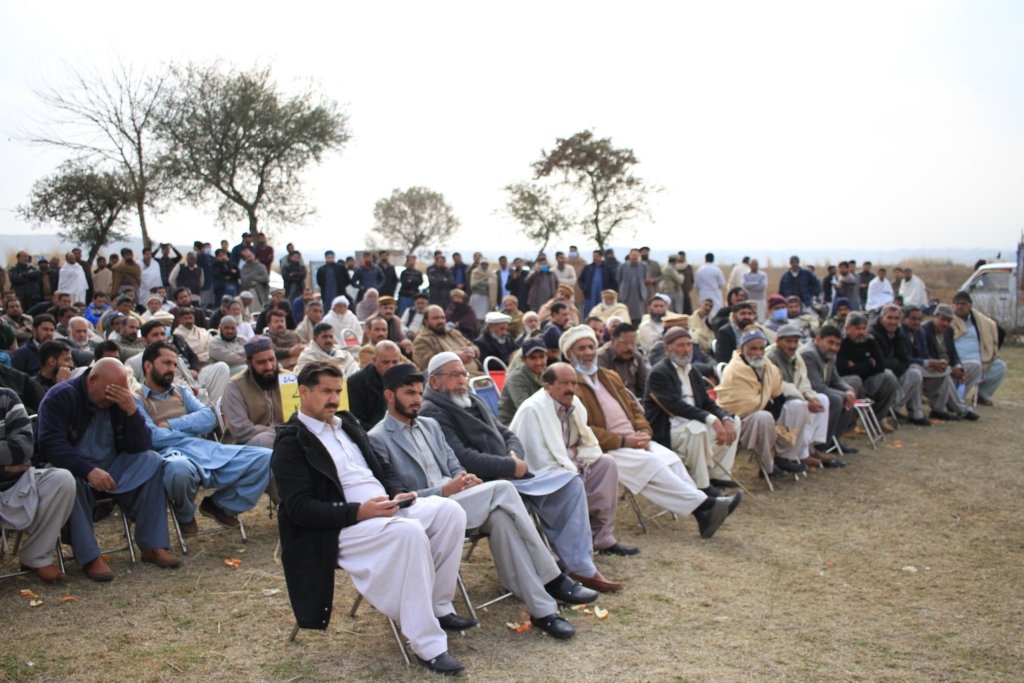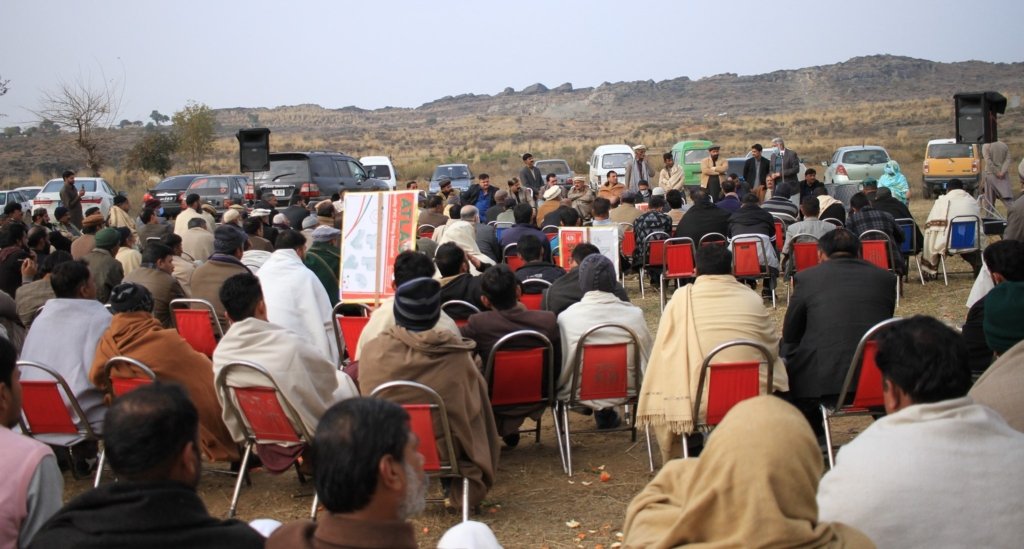Local people say they will not vacate their ancestral land without a settlement plan or resettlement by Punjab government; They demand increase in compensation rate for their land.
Rawalpindi: Affected people of Dadhocha dam organised a public meeting and peaceful protest march here on Sunday against forced displacement without rehabilitation, seeking a substantial increase in compensation rate for their lands and a resettlement plan.
The residents of Dadocha, Bharwala, Khanpur, Dhadhar Najaar, and Mohra Wains villages close to Kahuta-Rawat industrial triangle area attended the events in large numbers.
Because of the dam’s construction, over 400 households or nearly 4,000 inhabitants of over 5 villages falling in the dam’s reservoir area will lose their homes, agricultural lands and livelihoods.
The events were also attended by AWP Punjab President Ammar Rashid, party activists Hassan Turi, Ibrahim Bashir and Areej Hussain.
Local farmers and villagers said that the Punjab government and district administration had started construction of the dam without any settlement with the indigenous inhabitants or a resettlement plan. This was being done through the imposition of the outdated draconian Land Acquisition Act 1894 despite the fact that the matter was still sub-judice in the Lahore High Court (LHC) Rawalpindi bench.
Pervez Kiyani, a local resident, described how they were being offered a pitiful Rs5,000 per marla (100,000 per kanal) for their agricultural land which was a fraction of their actual market value while the non-arable land in the area under DHA’s possession was being valued by the latter at 7 million per kanal.
He said if they were forced to leave their homes at such a nominal rate, they would be rendered homeless as it would be impossible to find other homes or land in Rawalpindi or adjoining areas.

He called on Punjab Chief Minister Usman Buzdar and Prime Minister Imran Khan to take notice of the destruction of their livelihoods and to ensure they are justly compensated.
Speaking on the occasion, Raja Fayazul Haq Janjua, a resident and protest organizer, said that they were not against dam construction but it should not be done at the cost of the livelihoods of local people by their forced displacement who should instead be justly compensated and physically and economically resettled within the area.
He said that residents were not even sure if they could now bury their deceased loved ones in the local graveyard as that too would soon become submerged following the dam’s construction.
Residents further said that they were being dispossessed of lands that were even beyond the limits of those demarcated for the dam, ostensibly for commercial purposes.
Some residents spoke of how the adjacent DHA Valley had also occupied their ancestral lands despite the fact that a court had already ruled that it belonged to the villagers.
They said that this occupation by DHA was preventing them from resettling their households in the nearby location. They further said that it appeared that there was some collusion between local authorities and DHA (which was not objecting to dam construction without compensation) in order to get desperate residents to sell their lands at throwaway prices
Speaking on the occasion, AWP Punjab President Ammar Rashid said that such dispossession was the result of the fact that the state in Pakistan was still operating through colonial-era laws and norms of development.
He said that colonial laws like the Land Acquisition Act were designed by the British to allow them to easily dispossess and exploit indigenous inhabitants for the furtherance of their capitalist interests.
Mr Rashid said that there were precedents of resettlement and rehabilitation in past dam projects, but that was only made possible by the struggles of the affected people who forced the authorities to recognize their rights.
He said that residents should prepare themselves for a peaceful struggle to make their voices heard in the corridors of power and receive the compensation due to them.
After the public meeting, residents marched to the site of the dam where FWO had set up camp. They called on local site officers to abide by court orders and not begin construction work without reaching a just consensus-based settlement with the local residents.
The Assistant Commissioner Rawalpindi arrived on the site to negotiate with the protesters and said they would be called for a meeting with the district administration to discuss their demands, but expressed his helplessness that the matter was ‘out of his hands’.
The residents vowed to continue their struggle for their rights and said they would stage a sit-in outside D Chowk and outside the Parliament House unless their just demands were met.
Dadhucha Dam issue

The project was approved in 2002 but it has been lingering on for the last 18 years. Last year the construction work contract was given to a commercial wing of the army.
On December 2020 the Punjab government released Rs150 million to the Frontier Works Organisation (FWO) for starting work on diversion (flow pipe) and spillway of the Rs6.429 billion-Daducha Dam to be completed in three years.
According to a Dawn newspaper report, land acquisition was underway. More than 1,640 kanals of land had been acquired. Payment has been started to private owners.
However, the majority of the owners through their counsel Barrister Sardar Abdul Razziq have filed a petition in the LHC’s Rawalpindi bench against the rate of Rs75,000 per kanal.
According to the petitioners, the area is adjacent to Defence Housing Authority (DHA) schemes, Bahria Town and the Kahuta industrial area and the cost of land there is Rs5 million per kanal.
The petitioners contended that the government had decided to acquire 220 kanals located in Dadhar and Mangot.
The dam will be constructed on upstream of Soan River. Rainwater from Murree and Kahuta hills will be stored in a lake at Daducha village near Sihala on Kahuta Road.
As many as 10 villages, seven in Rawalpindi and three in Kahuta, will come under the dam. The project will affect 218 houses, seven industrial and commercial units and other areas. A notification under section 4 of the Land Acquisition Act 1894 was issued on Nov 3, 2010, to secure the land. The area is part of Kahuta, Kallar Syedan and Rawalpindi tehsils of Rawalpindi district.
The total storage capacity of the dam would be 60,000 acre-feet, dead level storage capacity 15,000 acres feet and the live storage capacity 45,000 acre feet. The water inflow to the dam would be 77,000 cusecs and the outflow is estimated at 42,000 cusecs. The total cost of construction of the dam is estimated at Rs6 billion and the project will be completed in a period of three years.
In 2006, the DHA purchased 18,000 kanals near Rawalpindi where the dam was to be built and launched a housing scheme as a joint venture (JV) with Bahria Town. The DHA Valley scheme meant for the families of martyred military personnel was proposed at the dam site.
On Aug 4, 2015, the SC in a suo motu case directed the Punjab government to construct the dam at the originally proposed site. Soon after the directive, the provincial government banned the sale and purchase of land in the area and later allocated funds for the construction of the dam in its annual development plan for 2017-18.
On SC’s directives, the Punjab government in 2017 initiated the process to construct the dam at a cost of Rs7 billion to overcome the water shortage in Rawalpindi.
In 2018, DHA, Bahria Town and Habib Rafiq Private Limited offered construction of the dam on a build, operate and transfer (BOT) basis. The Punjab government rejected the offer and submitted a report to the apex court against the proposed construction of the joint venture.
The report noted that instead of the government rate for the land, the JV had estimated the price of the land on the basis of its investment in the housing scheme, DHA Valley, which was lying dormant for over a decade.
As per the PC-I, the land acquisition was to cost Rs2.8bn whereas the JV had proposed Rs26.7bn which was to be borne by the provincial government. Moreover, the JV would bear Rs3.5 billion cost for the construction of the dam.
The feasibility study for the dam was approved in 2013-14 after which the irrigation department hired consultants for the purpose.
The total capacity of water storage in the dam is 60 feet, while the dead level has been estimated at 15 feet level.
On November 2 the government of Punjab had rejected the proposal of property tycoon Malik Riaz for the construction of Dadhocha Dam as the Bahria Town-led joint venture (JV) proposed over Rs26 billion for the acquisition of land against Rs2.8 billion worked out by the government.

The High Asia Herald is a member of High Asia Media Group — a window to High Asia and Central Asia


